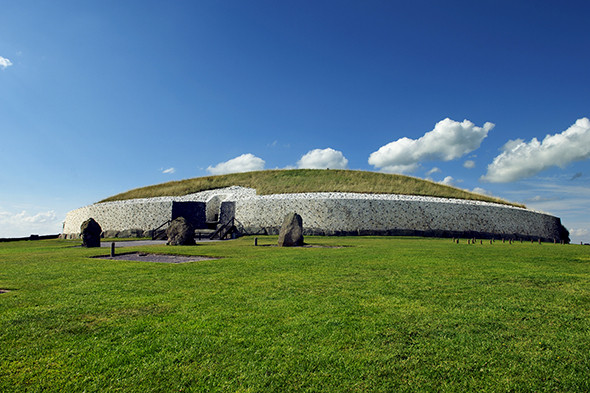Amazing Feats of Engineering from Before Electricity
We can only stand in awe in front of what engineers can achieve today. Just think of how many things have to click for a simple machine to work as it should - and then multiply it by a pretty large number in the case of some of the most amazing machines and buildings we take for granted today. You think that the Burj Khalifa could stand if engineers miscalculated the load capacity of its walls? Or that the ISS could keep its inhabitants safe if the materials used were not the perfect match for the job? Today's engineers have computers to calculate everything from wind speed to stress, not to mention the possibility to simulate everything before even laying a hand on a wrench. But think of the engineers of the past - they had to make do with paper and pencil (or sometimes their mind alone) to create some of the most amazing things that are still around us today. Like the ones below.

Newgrange
Newgrange is a prehistoric monument, built during the Neolithic (around 3,200 BC), which makes it older than the Egyptian pyramids. It is basically a large mound built out of alternating layers of dirt and stones - but this is not what makes it special. What's most interesting about it is its 60-foot-long passage with chambers at its end. On the shortest day of the year - the Winter Solstice - the sunlight passes precisely through the passage, flooding the chambers at its end with sunlight. Whether Newgrange was a religious structure or an astronomical or calendarist building is still unknown - but it works to this day.
The slot machine
One of the most successful pieces of engineering that are still around today is the slot machine. Although it has mostly become a simulation today, as we play them on screens in pubs, casinos, and online at https://www.7sultanscasino.com/, there are still century-old models around (mostly at collectors). When he built his first slot machine, Bavarian mechanic Charles Fey probably didn't even imagine how important his design will be for the gambling industry. Today, slot machines are among the most-played casino games, both online at the 7Sultans and in real life, in places ranging from gas stations and pubs to high-profile casinos. The games at the 7Sultans are far more complex than what Fey has built in the late 19th century but they retain many of his original ideas.
The random number generating capabilities of the original "Liberty Bell" were amazing in themselves but they are not the most interesting solutions Fey used. What was amazing, in turn, that he managed to attach automatic payout mechanisms to every possible winning combination of the symbols, allowing the slot machine to function without human assistance. Besides, he even built a mechanism to tell the difference between a nickel and a button or a metal disk of the same size. Through this remarkable piece of engineering (which he couldn't patent at the time), Charles Fey created the mechanical gaming industry.
Hero's Engine
Hero of Alexandria was a mathematician and engineer who lived in Alexandria between 10 and 70 A.D. He was the "Leonardo da Vinci" of the ancient Greece - his inventions were so much ahead of his time that some suspect he might have been a time traveler (just kidding). Among the things he invented almost two millennia ago we find a rudimentary steam engine (known as Hero's Engine), a rocket-like reaction engine that, for the first time, transformed thermal energy into kinetic one. But this was not his only amazing feat (even though it predates the Industrial Revolution by almost two millennia). Among others, he created a wind-powered organ (it was the first time eolian energy was used to operate a mechanism), a standalone fountain that operates under self-contained hydrostatic energy, and a vending machine that dispensed a set amount of holy water when fed a coin.
Automata
Badīʿaz-Zaman Abū l-ʿIzz ibn Ismāʿīl ibn ar-Razāz al-Jazarī (Ismail Al-Jazari, as he is known in the West) was a Kurdish inventor, engineer, innovator, scholar, artist, and mathematician who lived between 1136 and 1206 AD. Most of his innovative solutions were amazing for the time but none were as cool as his automata. Aside from automatic doors and gates that were powered by hydropower, he also created moving peacocks, a robotic waitress that could serve water, tea, and drinks, anthropomorphic automata offering soap, water, and towels to those washing their hands, and the world's first robotic band - a boat with four musician automata that floated on a lake to entertain guests at royal drink parties.

Newgrange
Newgrange is a prehistoric monument, built during the Neolithic (around 3,200 BC), which makes it older than the Egyptian pyramids. It is basically a large mound built out of alternating layers of dirt and stones - but this is not what makes it special. What's most interesting about it is its 60-foot-long passage with chambers at its end. On the shortest day of the year - the Winter Solstice - the sunlight passes precisely through the passage, flooding the chambers at its end with sunlight. Whether Newgrange was a religious structure or an astronomical or calendarist building is still unknown - but it works to this day.
The slot machine
One of the most successful pieces of engineering that are still around today is the slot machine. Although it has mostly become a simulation today, as we play them on screens in pubs, casinos, and online at https://www.7sultanscasino.com/, there are still century-old models around (mostly at collectors). When he built his first slot machine, Bavarian mechanic Charles Fey probably didn't even imagine how important his design will be for the gambling industry. Today, slot machines are among the most-played casino games, both online at the 7Sultans and in real life, in places ranging from gas stations and pubs to high-profile casinos. The games at the 7Sultans are far more complex than what Fey has built in the late 19th century but they retain many of his original ideas.
The random number generating capabilities of the original "Liberty Bell" were amazing in themselves but they are not the most interesting solutions Fey used. What was amazing, in turn, that he managed to attach automatic payout mechanisms to every possible winning combination of the symbols, allowing the slot machine to function without human assistance. Besides, he even built a mechanism to tell the difference between a nickel and a button or a metal disk of the same size. Through this remarkable piece of engineering (which he couldn't patent at the time), Charles Fey created the mechanical gaming industry.
Hero's Engine
Hero of Alexandria was a mathematician and engineer who lived in Alexandria between 10 and 70 A.D. He was the "Leonardo da Vinci" of the ancient Greece - his inventions were so much ahead of his time that some suspect he might have been a time traveler (just kidding). Among the things he invented almost two millennia ago we find a rudimentary steam engine (known as Hero's Engine), a rocket-like reaction engine that, for the first time, transformed thermal energy into kinetic one. But this was not his only amazing feat (even though it predates the Industrial Revolution by almost two millennia). Among others, he created a wind-powered organ (it was the first time eolian energy was used to operate a mechanism), a standalone fountain that operates under self-contained hydrostatic energy, and a vending machine that dispensed a set amount of holy water when fed a coin.
Automata
Badīʿaz-Zaman Abū l-ʿIzz ibn Ismāʿīl ibn ar-Razāz al-Jazarī (Ismail Al-Jazari, as he is known in the West) was a Kurdish inventor, engineer, innovator, scholar, artist, and mathematician who lived between 1136 and 1206 AD. Most of his innovative solutions were amazing for the time but none were as cool as his automata. Aside from automatic doors and gates that were powered by hydropower, he also created moving peacocks, a robotic waitress that could serve water, tea, and drinks, anthropomorphic automata offering soap, water, and towels to those washing their hands, and the world's first robotic band - a boat with four musician automata that floated on a lake to entertain guests at royal drink parties.



